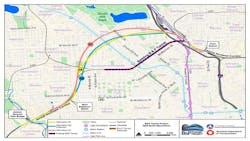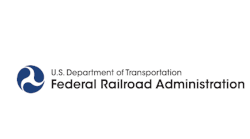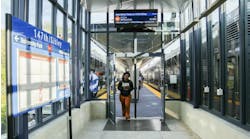FRA Completes Environmental Review for New B&P Tunnel
The Federal Railroad Administration (FRA) has finished the environmental review (final environmental impact statement, or FEIS) to replace the Civil War-era Baltimore and Potomac (B&P) Tunnel. The FEIS includes review of the route (Alternative 3B) for a new tunnel and incorporates changes sought by communities and neighborhoods in Baltimore during more than two dozen meetings held over the last two years. “Rebuilding the B&P Tunnel is a significant undertaking along the Northeast Corridor,” said U.S. Transportation Secretary Anthony Foxx. “I am encouraged by the input provided by the communities, and that much of that input led to changes to make this project better for everyone involved. This is a great example of the value that public engagement and community involvement bring to the transportation planning process.” In response to the input provided by communities and leaders in Baltimore, FRA relocated the ventilation plant location to West North Avenue to preserve a community garden, reduced the number of land parcels and historic properties impacted, decreased proposed relocations, and maintained the proposal to rebuild a larger and ADA-compliant West Baltimore MARC station. The review includes proposed mitigation measures to address the impacts created by the route. These measures include establishing several grant funds to support community development and recreation facilities, providing project-related job training and hiring preferences for local workers of social and economic disadvantage, implementing construction noise and vibration mitigation plans, and establishing a grant fund for historic preservation. The new tunnel would be about 100 feet underground, compared to the existing tunnel’s 20-foot depth. The deeper placement would nearly eliminate any noticeable vibrations from passing trains. “This project is better because communities provided input on how a new tunnel could be built with as little impact as possible, and where there was an impact, how we can reduce it,” said FRA Administrator Sarah E. Feinberg. “The new tunnel will keep trains moving along the Northeast Corridor and create jobs in Baltimore.” The federal government has invested $60 million for the preliminary design and environmental review for this project. The state of Maryland estimates the project could create or support 7,000 jobs a year, over seven years, with more than 50 percent of those jobs in construction. The new route will smooth out existing curves, enabling trains to double their speeds. About 140 Amtrak and MARC passenger trains and several Norfolk Southern freight trains currently travel through the existing tunnel daily, which is part of the Northeast Corridor, the nation’s busiest rail corridor. The new route will allow 388 trains to use the new tunnel daily. In December 2015, the FRA presented three proposals for replacing the Civil War-era tunnel in a Draft Environmental Impact Statement (DEIS). This past April, FRA revised those options following further feedback from Baltimore residents during public hearings held in February. While Amtrak owns the B&P Tunnel, FRA leads the environmental review process in cooperation with Maryland’s Department of Transportation. Compared to Alternative 3A and Alternative 3C, Alternative 3B (the Preferred Alternative/new route) best meets the project’s purpose and need while minimizing environmental impacts. It provides high-level platforms for a newly rebuilt West Baltimore MARC Station, involves only minor impacts to the P. Flanigan & Sons asphalt plant (a major local employer), preserves two historic buildings that would be demolished by Alternative 3C, and improves average train travel time.



